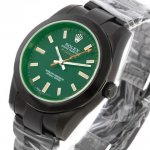Chemical Profiling Could Help Expose Replica Watches
Replica watches are posing a growing threat to the Swiss luxury watch industry, especially as “super-fakes” become increasingly difficult to spot – even by trained experts. Rolex is a prime target of counterfeit watch makers, though some other brands ranging from Panerai and Omega, to Patek Philippe and Audemars Piguet are becoming the popular targets as well.
These “superwatches” are exquisitely crafted and nearly perfect in every detail, demonstrating the need for new technology to help eliminate the threat of fake watches before they start to have a real detrimental effect on brands’ profits. In fact, Swiss researchers now believe that by detecting trace metals in their ingredients, they can tell the difference between genuine and fake watches and help determine where they came from.
Using a sample of 35 replica rolex watches, scientists from the University of Lausanne, the Cantonal Laboratory of Vaud, and the anti-counterfeiting department of the Federation of the Swiss Watch Industry analyzed the watch cases using inductively coupled plasma mass spectrometry, in order to get a readout of the elemental composition of the metal.
According to Securing Industry, which reports on supply chain and brand security, “the team found they were able to group some of the fakes according to their compositions.” They then cross-referenced the findings with previously-gathered intelligence about the provenance of confiscated fake watches and where they were seized. “Some of the chemical profiling data corroborated existing knowledge,” the site notes, “while others revealed new connections between different seizures and specimens.”
The findings, published in forensic science international, suggest that the complex and expensive machines needed to make truly high-quality counterfeits have been found only in “a limited number of production sites”, narrowing the field a bit.”Cases from the same production batch are made from the same materials and should have the same chemical composition,” the researchers explained.
So if researchers can create a chemical signature for certain fake watches from a particular location, they should be able to identify future fakes from that location. While the Swiss replica watch industry produces about 30m genuine watches a year, 9 per cent of all customs seizures are now counterfeit. Unless the Swiss scientists figure this out, we expect that number to only increase.

